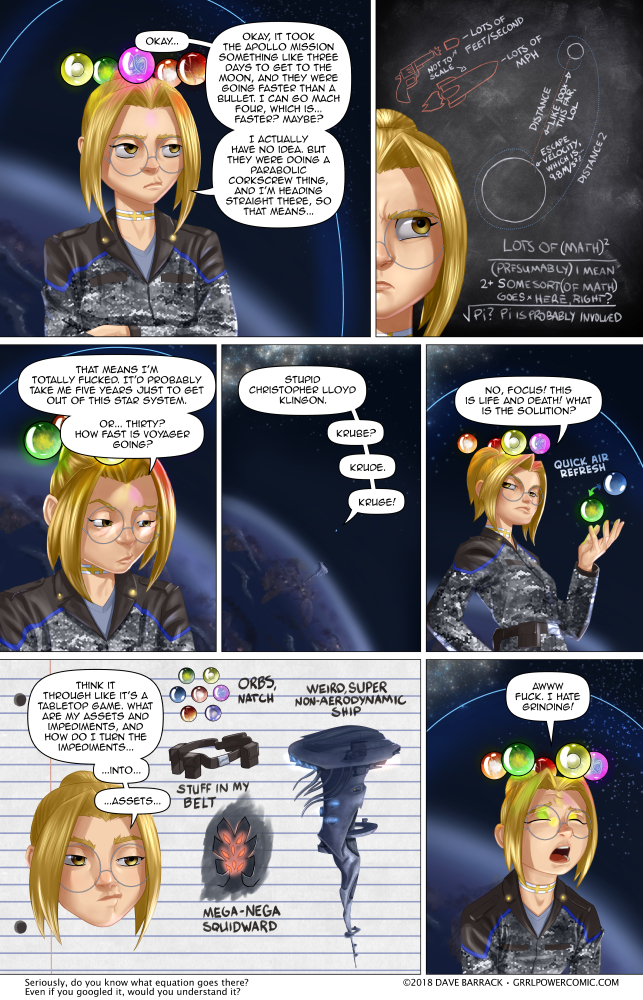Grrl Power #654 – Dejectory
It’s easy to take for granted that smart people in comics (and books, tv, etc) are smart because we see them standing in front of a big board of math – usually a clear board, which looks fancy and futuristic but would probably give you a headache trying to not focus through it. >cough< But the actual smart stuff is always off screen. We never see the process because the writers aren’t as smart as, for example, Reed Richards, who invented a time machine in, like, issue 2 of the Fantastic Four. But even if the writer wants to do a bunch of research just to even have the right equation on the big board for the 0.03% of the audience that would even notice, it’s not like an averagely intelligent character like Sydney would even be able to utilize information like that. (Okay, Sydney has exhibited above average intelligence on occasion, but not “inventing a dimension hopping portal gun” intelligence)
I mean think about it, do you really know what E=MC^2 means? Sure, you know E=Energy, M=Mass, C=The Speed of Light, but without googling it, do you know what the units are? Is E joules or newtons? M=kilograms, probably? And really, if you were on an alien space ship, and you had to program your confiscated railgun with just the right amount of power to punch through the door in front of you, but too little and it ricochets back and kills you, too much and the projectile rips through the bulkhead into space or into the reactor and kills everyone – could you do it? Using E=MC^2. You can’t fire a bunch of shots till you get it right, messing it up kills you at best or everyone at worst, can you tell me you REALLY understand E=MC^2?
Anyway, that’s why I thought this page was funny, because for the briefest flash, Sydney tried to actually mathematically work out space travel in her head. Dabbler would be all “Yo I got this.” but have you guys seen Hidden Figures? NASA had buildings full of really fucking smart people and it took them months to figure that shit out. (And a computer that could do over a thousand computations per second, watch out!) Sure, they were concerned about fuel and oxygen and angles of launch and reentry, and Sydney doesn’t have to worry about any of that. But STILL.
BTW, I know Sydney says it took the Apollo missions took three days to get to the moon, comments on the previous page mostly said four. The point is, Sydney doesn’t have access to the internet and she’s mentally breaking down already.
Double res version will be posted over at Patreon. $1 and up, but feel free to contribute as much as you like.
















If actual realistic physics of flight are in play (other than violating conservation of momentum) Halo probably has a fairly prodigious thrust from the flyball, given that she tops out at Mach 4 nearish to sea level despite the drag from a fairly large spherical shield.
If one called her usual shield a perfect sphere six feet in diameter (her being five feet tall, that seems reasonable), and she weighs about 125 pounds (plus another 8 or so pounds of air inside the shield) you’re looking at nearly 1.5 million newtons of thrust — less than an SSME at lift-off, but Sydney weighs rather less than the Space Shuttle.
Put another way, in a vacuum that would be 24,500m/s/s of accelration, or about 2,500 times Earth’s gravity — which would get her from the Earth to the Moon in about four minutes, so the flyball definitely does not use normal physics.
As a note, that’s four minutes using an as-direct-as-possible brachy trajectory, and these numbers are all rather off-the-cuff — I’d appreciate any corrections.
On a logistical note, that means she has enough acceleration that, given the lack of remass consumption, she doesn’t need to actually do any navigational math. You can just aim for the moon and fly by the seat of your pants at those distances and velocities.
Of course 24,500 m/s^2 would also turn her into pasta sauce. Given her lack of athleticism, I would put her maximum sustained accel around 2 to 3 G. Assuming the flyball doesn’t produce totally uniform acceleration of course. Which it may. At which point, 24K m/s^2 it is! Also, with that kind of acceleration, she would be really useful for studying objects at relativistic velocities! Assuming there isn”t a really low top speed limit for whatever reason. Magic makes things both easier and harder all at once…
Not if the acceleration is applied simultaneously to every atom in her body. Which it might be it doesn’t seem to be pushing her from behind or something.
Well I’m not sure the turn-into-pasta-sauce thing would be a problem I mean she went to match 4 without any ill effect (without even noticing mind you) so I’m pretty sure that her spheres give her the ability to bend centrifugal forces or be inmune to that or maybe the shield does, may be her fly-sphere works like an Alcubierre engine (A.K.A. warp engine) although very limited by the speed at wich it can bend space-time… it would be very cool if she can unlock FTL warp travel in her skill tree jajajaja
The idea of Sydney trying to compute a brachistochrone cord in her head is pretty funny. I doubt even John von Neumann could have done that, and he was known for outpacing early 1950s computers.
However, given that maximum acceleration, and the fact that she can adjust her path in flight by eyeball, an optimum path might not really be needed here. It would take longer to compute it than to just fly by the seat of her pants at that point.
Mind you, the von Neumann legends about him testing a new computer and tweaking the design until he could no longer outrun it were… exaggerated, would be a polite way to say it. Johnny was using a trick which other mental calculators still use: he couldn’t really beat the computer, but he could start giving an answer before the computer had finished and printed it out to whatever readout system was used (which in those days may would have been either a paper printer, a series of nixie tubes arranged as a digital display, or even a card punch (which would give him plenty of time to work). For that matter, he could start working on the problem while the operator was still setting it up in the computer. There are also a bunch of tools one can use in mental math such as casting nines and square-and-add that would reduce the actual effort of some kinds of computations, and for algebraic or calculus problems he’d have a serious advantage, as he’d died before modern automated symbolic algebra techniques had even begun to be researched.
Simple mental math is easy enough, and can be taught to even someone who was math phobic (as I was until I learned). However, it does require both a good memory and a focused concentration, even if only for a short while. How’s that part working for you, Sydney?
Actually, I’m hardly one to talk when it comes to ADHD. While I am not in as tough a spot as, say, Ted Nelson – whom I’ve met a few times, he’s a great guy and wonderful conversationalist even if following his line of thought is like trying to grab jello sometimes – but focus and I are rarely on speaking terms. You have my sympathies, Syd (and Dave B., too, of this is personal experience speaking).
Also, I don’t know for certain if that was what Johnny von Neumann was doing, but my own experience with it, and what I’d read in the book I learned from (The Great Mental Calculators by Steven B. Smith – interesting read, by the way, if you’re into the psychology and all that) leads me to think it is likely that he was doing that sort of thing.
You don’t need navigational math to get to the moon, which has precisely nothing to do with getting home. At stellar distances, you need precise math because a teensy-tiny difference in angle away from straight on gets multiplied by light-years–and that’s if you know which star to zip to in the first place. And what happens when Sydney needs to sleep on her voyage? If she lets go of her balls when she sleeps, is she going to be a frozen space-corpse? That’s a problem anywhere there’s no breathable atmosphere. If Planet Doomsday here has a breathable gas ball, even with the invading warship it might be a better place to stay than anywhere she’s likely to reach.
Anyway none of this is going to be the thing that gets her out of this pickle. The big question is do we get a nice survivalist arc out here with Sydney and her dreadlock friends, or is someone going to drop in on her nice and quick and be her… I don’t read enough comic books to come up with a good analog. Be her friendly alien exposition whoosit. Or whatever.
That suggests to me that the fly orb doesn’t accelerate continuously, or she would have been near the moon by the time she stopped to reassess the situation.
I did some more exact calculations on the last page ( https://www.grrlpowercomic.com/archives/2918/comment-page-2#comment-691124 ) and got around 600Gs. The drag coefficient on it is the biggest guess but it’s a linear part so if the drag coefficient is off by 10% then the answer is off by 10%.
A few questions.
She’s gonna need to eat at some point, interstellar travel or not. That planet looked pretty barren to me, and I wonder if the Alari even needed to eat? And if they did, can Sydney eat it too?
What is even flight orb? Does it have a maximum speed because of air resistance or something similar, implying a limited yet upgrade-able source of thrust force? Or does it just change her position relative to the passing of time, or some shit like that? If it’s the former, she should be able to go really fast, maybe even approach light speed without too much trouble. If it’s the latter, could she rig some kind of makeshift thrust using her shield orb and the life support orb? Make a tiny hole in the shield, and use the escaping air to provide some thrust, meaning that she could (eventually) surpass the max velocity of the flight orb.
Relative to that, how much wood can that life support orb chuck? Does it have a limited supply of air? Does it convert surrounding matter into air? Is it solar powered, and as soon as she leaves the solar system, she’s fucked? Is it powered by lepton condensation? By Teletubbic static charm force? Snapple facts?
My suspicion is that the last orb handles nutrition, and possibly waste disposal and hygiene as well. Unless the air orb does that and we simply haven’t noticed.
I’m also beginning to suspect the orbs were designed for someone with more than two hands.
Perhaps the true owner of the orbs could simply access al their functions while they orbited around him/her/it? Seems by far the most efficient way to use them; that Sydney can’t do that doesn’t mean all that much since the owner probably belonged to a more advanced species than just plain old humans.
I swear at first I read “I wonder if the Atari needed to eat”… mmm, tasty ET cartridges…
That’s what really happened to the ET cartridges – some employee was at work late playing games and lost track of the time. When he put in a cartridge after midnight, the console started eating it and he had to feed it the entire ET shipment to buy time while they figured out how to kill it. Then they buried everything it the landfill to keep it forever out of direct sunlight.
And like reckless fools they dug them up. They were warned not to do what science and technology could not, but no they would no listen. Provided they don’t read from the (user manual) book, we may be safe, but who knows what evil they have unleashed upon the world! We are doomed, DOOMED I TELL THEE!!
Help me out here, when did we determine the green orb provides life support? I seem to have missed it.
Starting here: https://www.grrlpowercomic.com/archives/2560
I can’t recall either, but that’s probably just me; if all else fails, one can always just go back and reread the series so far; it’s not like it’d be a burden :P
The pool training episode. She lost her shield and got caught, and in a moment of panic grabbed the green orb, which put a sphere of air around her.
Or did the Life Support Orb anticipate her needs? She’s not panic-grabbing it, she nudges it with a finger and a flies into her palm.
She was reaching for her respirator and it came to hand. Kinda like how the shield orb comes to hand as part of her flinch reflex.
You missed Varia getting sopping wet, how could you forget that?
For the units in the E=mc^2 equation, it’s a descriptor of how much energy a given mass contains, and I usually just go with the Kg(m/s/s) since it’s easier for me to remember. For motion, I think you’d be talking Joules, but I’m no physicist, which only emphasizes the point.
You have the wrong unit for energy there. That’s the unit for force, not energy. Energy is kg(m^2/s^2) . . . which is a joule.
Take a step back. F=ma (force = mass * acceleration). That’s where we get kg(m/s/s) . . . which is a newton. (Force, not energy, is measured in newtons.)
Energy = work = force * distance through which the force is applied. That gives us newton-meters (Nm) . . . which is a joule.
So, for E=mc^2 it’s energy in joules, mass in kg, and speed of light (in a vacuum) in m/s. And no, I did not look any of that up.
To take it a step further, power = energy / time. Which gives J/s . . . which is a watt.
And absolutely none of this helps in calculating the settings for your railgun. You’d need a different equation (actually, about three of them, one of which probably involves integral calculus) entirely for that, and also need to know the tensile strength of the door in question, the mass of your projectile, and the density of the air between you and the door. The good news is you have some room for error on the high side. If you assume the tensile strength of the wall on the far side of the room is at least that of the door you’re trying to break down, you can go over by quite a bit, as long as you don’t more than double what you need.
E=mc^2 is largely only useful in nuclear reactions. Now if you had a plasma rifle rather than a railgun, you might need E=mc^2 for that. You’d still need to know the tensile strength of the door, mind. And if thermal blooming is a problem, then you’re toast whether or not you successfully break through the door.
Yeah…if you’re using E=mc^2…to calculate anything about a railgun…you’re probably going to run into problems if you ever pull the trigger.
The units don’t really matter, only that they all cancel out correctly. Plus, I’d add that the equation being used is actually oversimplified for the situation. E=[gamma]mc^2 would be better for pretty much any space travel, especially since with the distances we assume she needs to cover, only relativistic speeds would let her arrive in her lifetime (probably not the others’, but eh).
More importantly, I wonder if the consideration of E=mc^2 belies that the orb is using/getting energy this way. Maybe the flight orb imparts a certain amount of kinetic energy reliant on the mass of whatever’s inside the shield?
I was wondering if anyone would bring this up. Dave picked a bad example for me because E=mc² is one I actually do understand well.
For the railgun if it has a decent user interface you might just need to just adjust the speed knob on it so you could use E=mV² (if you knew the slug’s mass) to know how much energy it’s putting out (maybe it’s a forcefield not a door so you don’t need to worry about loss due to penetration).
As I said, I’m no physicist, just a failed engineering student (physics was one of the classes I failed, so…), so thank you for the correction.
I AM a physicist, and all I can say about units is that they can be REALLY hard to wrap your head around. Especially with theory papers, that don’t make the units explicit and may require reverse-engineering what units an equation is stated in. Especially when certain properties have different prefactors (with non-units unit) in different conventions.
As for E = m c^2: That one’s pretty easy, as energy, mass and speed have clear units, so it is harder to get it wrong than right. Though that might be a case of tunnel vision. After over 10 years of bachelor-master-PhD it is hard to remember how far „common knowledge“ goes.
Question. Do the orbs need recharging or do they have access to unlimited power? First time reading comments, so this question probably has been previously asked.
As far as I know, we’ve never seen them need to recharge, but they do seem to go “dormant” when Sydney is sleeping. So, maybe they recharge then? But I don’t think we know where they get their power.
Maybe they’re using ‘zero point’ energy?
I mean, if you have some impossible objects, why not power them with the impossible power source?
for all we know they have two portals to matter and anti-matter universes, maybe a portal to the inside of a sun etc.
But we have not really seen if that power source has any upper limit.
The shield might have, but we also may have seen a sudden and extreme buffer loss before the main power / backup system could kick in to rectify the problem. They do that now for power to buildings in a ‘please don’t fail us now’ power outage. the temp buffers handle the sudden ‘spike or drain’ on the system, and if a drain keeps going (main power not on etc they the back generators kick in. eg a UPS power system
I can answer your E = MC2 question. But you aren’t going to like it… 42. What ever units you want, mind if you mix fortenites, furlongs and metric it may cause some mental instabilities.
While I’d normally agree with your rant about equations, unless I’m missing something here, the math Sydney needs is actually incredibly simple. It’s just distance times velocity equals time.All the complicated stuff comes in once you want to start accounting for orbital mechanics and pulling slingshot maneuvers, but she doesn’t actually need to (and quite possibly can’t) care about any of that stuff, given what we’ve seen of her orbs.
Also, I’m pretty sure your railgun example just wants F=MA or Ke=.5MV^2. The bigger issue would be the interface designed for aliens, in an alien language (assuming anything is labeled or user modifiable), and using alien units.
Minor correction, the first equation she needs is distance over speed. …
I said the equation was simple, not that I was awake.
Besides, the Einstein’s equation E = mc^2 is for converting mass into energy and relates the relation between matter and energy. In short, it is really only useful if you are interested in nuclear physics / nuclear reactions because that’s usually when changes to mass gets converted to energy. It would be as useful, say, accounting formulas for calculating the velocity of bullets needed to punch through a door. Those two things are entirely unrelated.
Yes, but the rail gun measures it’s ammo in matter antimatter annihilation.
Actually the railgun equation is probably really simple as well, simpler than you’re thinking even. You don’t care about the force – you care about the setting on the gun. Which is the efficiency of the gun times the amount of energy you want to impact the door with.
Did the patreon update? Recently, my patreon glitched out or something and posts wouldn’t show up. Just checking if it was posted yet
I have been hearing rumors that Patreon was just shut down for supporting NSFW creators.
You know, I was going to try to do the math assuming she gets into an orbit and then just integrate her acceleration and the earths acceleration until she was in desynchronous orbit with the moon (at which point she can just wait for it to come around, but I just realized she’s working with a velocity propulsion system, not acceleration. How fast is the moon moving? Is it much faster than mach 4? if so she can’t catch it, and hitting it would be painful. Otherwise she literally can just move towards the moon until she reaches it. (and if we can take a guess at the moons period, then arriving at the moon in a straight line just becomes Pythagoras theorem.)
To say that because you cannot use Einstein’s equation for converting mass into energy (which is mainly used for nuclear physics and reactions when such things happen) for finding the velocity of bullets needed to just punch through a door then you don’t understand it is as ridiculous as saying that you don’t understand the formula for the area of a triangle if you cannot use it to find the change you should be getting after paying for your groceries. The velocity needed to punch through the door has as much to do with matter-energy convertion as area of triangles and buying fruit.
Also, the reason why you cannot use equations to predict everything all the time is that equations are just models and often they do not model real life exactly. There are always things like friction or entropy or something probabilistic (like the exact amount of stress needed to make steel fail – we can say that steel most likely break at a certain stress but we cannot say that it is definitely going to fail) that equations cannot exactly model. Also, there’s need to take into account that the velocity of the bullet needed to break the steel door is going to be greater than the velocity needed to destroy the generator behind, or the two is just going to be so close that it is impossible to adjust (because of equipment measurement error) so the point is moot,
Equations can give you ‘off-the-cuff’ numbers – Ones that give you ‘close-enough’ answers that in 99.9% of the cases are all you need.
It’s the borderline and downright weird things that really drive ya bonkers. Example: relativity and special relativity.
Another example is when matter changes from different forms eg gas, liquid, solids and plasma. Example: Water when it changes from liquid to solid expands, most others shrink or shrink on a smooth curve.
further things like Carbon and structure – Carbon fiber and carbon nano-tubes etc was a third stable form just found recently.
Makes perfect sense to me.
People use all kinds of devices in their day to day with only a barebones to almost nonexistent understanding of how the technology works.
Solution: Get aboard the alien spaceship, and either negotiate with the aliens or kill ’em all. They’ll have communications, at least. Maybe the last orb is a Translatorb.
Or just wait for Dabbler and Harem to work those equations for her. Halo knows how fast Dabbler can work her mathemagicks to trace a teleport. Have some faith.
As the planet is now dead, I wonder if Sydney will try a high orbital bombardment strike to (a) level up and (b) avoid conflict with Mega-Nega-Squidward? And, heck, if that spaceship just so happens to be in the way, then that’s good right? It is below her after all…
Once Dabbler gets the portal back open, Max will set out on “Operation Save Sydney.” However, once she arrives on the scene, Max will have to quickly rename the operation to “Operation Save What’s Left of the Mega-Nega Squidwards from the Wrath of Sydney.”
@DaveB knowing the equations and their values depends on your field of knowlege, i could tell you every unit they have and i know the approx value of c (3*10^8 m/s is very close) becaus you need that in electrical engineering and physics quite often. Since the lightspeed is a speed it is always m/s as for energy thats joule and a mass is always in kg – thats the beauty of si values/equations. Joule equals kg*m²/s² and if you look at the formula E = mc² thats eactly what the units will be but i doubt normal people on the street will know that or somthing like the charge of an electron or an approximat of how many atoms are in a cubic centimeter of normal matter. In a comic/series/movie it´s always a nice gimmic if the equations are at least a bit corresponding to what they should show but it´s not a must as long as the story is entertaining. Just keep it that way and it will be good. It´s not a physics paper =) (btw that just my opinion)
For the railgun question – You need the full equation in that situation. E=MC^2 is the simplified version, when the body’s at rest, which we can use in most cases because the other two thirds of the equation is a ratio against C, so for practical purposes anything we interact with on a daily basis is at rest. (Note that this equation is also the one that says we can’t go faster than light – because E goes to infinity as v approaches C.)
A railgun in a sci-fi setting is typically a relativistic weapon, so the full equation will come into play.
(Of course, for that actual situation there is a useful simplification. You don’t really care about the energy of the projectile, you care about the energy you need to feed into the gun. Assuming you have some idea of how much energy it will take to destroy the door – and if you don’t have that, you need a completely different set of equations – you multiply that by the expected efficiency of a railgun in your universe, and that’s your setting, assuming the projectile is not explosive.)
If you take out the speech bubble from the last panel, the look on Sydney’s face resembles another form of “Grinding” she likely would enjoy.
So DaveB…
I kinda get what you’re trying to say there with minutiae math and vectors and physics being incredibly complicated, but it really kinda bothers me that you seem to be getting the basics wrong too…
-E is traditionally Joules, because Joules is a measurement of energy, but if you really wanted to, you really don’t have to use SI unit… you could invent any unit you want, (eg a DaVE; the amount of energy it takes to increase the temperature of one pound of pure water by one degree Fahrenheit)
-Newtons is a measurement of force (again, no need to use SI. Use the good old pound, if you so desire). Please don’t confuse it with Energy. Energy may not exert force at all (eg heating water). This force also includes force of friction. (So pushing something that has higher friction would require more energy over the same distance as compared to something with less friction; E=Fd)
-Also. It really, REALLY, REALLY bothers me that you’re using E=MC^2 wrong! Especially since it seems like you know what it means, having defined E, M, and C correctly! You really shouldn’t be (and probably can’t) use E=MC^2 for calculating railgun power unless for some strange unknown reason your railgun a) uses nuclear batteries [converting its battery mass into pure energy] and b) has a super terrible design flaw in that for some inexplicable reason it tells you the mass it expends but not the energy…
(And no, I didn’t look this up. I would really hope that you don’t really need to given that basic physics is taught in grade school. It’s kinda same tier as: “Who’s the first President of the USA?” and “What is a homonym?”)
Equations you’d be better off with is figuring out the elasticity of the collision with the bulkhead, whether your railgun projectile has penetrating power (compare FMJ bullets vs just normal bullets)… and how about whether you should even be using a railgun to pierce a bulkhead in the first place?!?!? (Like, aren’t there better tools around somewhere? A plasma-cutter? Maybe manual door control overrides??? Or maybe go around the bulkhead by demolishing a wall instead of through it?)
—
Sydney seems to be doing fine and not having a mental breakdown. She’s complaining about having to level-grind instead of hyperventilating, lol. And the fact she’s complaining about grinding also sounds like she’s got a plan too. Things are fine!
And… that comment came out way more condescending that it was supposed to. I apologize for that.
I stand by my points though. Seems like @lightdefender and @WLU also made similar points about the incorrect use of E=MC^2 too. It’s only ever used if you’re trying to figure out how much pure energy you get from pure mass conversion (or vice-versa; revolutionary because of the idea that energy = mass!!!)
You realise that it might be Sydney that’s getting the physics wrong and not DaveB.
Personally, I get the feeling that between panel 2 (which I find hilarious) and his notes for this strip, DaveB is both giving us all a nod for being big enough nerds to actually debate the physics of his character’s powers in the comments, and lampshading the fact that this is a comic and he’s not going to waste of bunch of time on nailing the details of orbital physics instead of telling the story.
Yes, it’s complicated and way over Sydney’s head, but the gist is that she’s not able to explore the solar system at this point. I think this is a brilliant way to acknowledge that and get on with the grinding so that story hijinks can ensue.
Let’s face it, we are nerds, we live for this shit! (Starts re binge watching YouTube episodes of Because Science, Scott Manly on Kerbal and Vintage space to get the maths done).
Get shoot and hope you don’t die generally isn’t a good plan, but it’s the only plan you’ve got.
So many smart and educated people posting here. I wish I could think of something clever to post so I could feel like one in the club of intelligent fans of Grrl Power.
Seriously. All the maths is hurting mine eyes. Less logic, more super exploring!
Sydney stlll hasn’t figured out that once she leaves the atmosphere, she can keep accelerating Ad Infinitum, at least until relativity kicks in and time dilation slows her time down.
Anyway, have fun re-enacting Apollo 13 (Which was in fact a real thing, despite how the “we never went to the moon” people think it was faked), Sydney,
I wouldn’t be surprised if she says “Houston, we have a problem” at some point.
Have they ever Torsten the range of the comm orb? She could try to send a hologram back to Earth and then teleport through it like she before. That would solve the travel dilemma if it works.
“Torsten” is apparently autocorrect for “tested”. Seriously what language is autocorrect changing some of these words into?
Scandinavian? lol.
It’s a name, anyway.
The comm orb has to send the light bee there physically first.
Let’s see, it’s been a while since I’ve done physics. E=mc^2
Mass is kilograms in SI units, and speed is in meters per second. So the units of the right side would kg*m^2/s^2, and I happen to vaguely recall that newtons are that. So E is in newtons, not joules. I think, just off the top of my head when I haven’t read anything related to physics for a few months.
Oops, recalled incorrectly. Newton is apparently kg*m/s^2.
Energy is measured in Joules. Newtons is the unit for force.
distance [d or s, depending] = m
speed (or velocity as a vector) [v] = m/s
acceleration [a] = m/s^2
momentum [p] = kg m/s = Newton seconds
force [F] = kg m/s^2 = Newton
work [W] = kg m^2/s^2 = Joule
energy [E] = kg m^2/s^2 = Joule
power [P] = kg m^2/s^3 = Watt
All other things aside (in case it hasn’t been mentioned as I haven’t read all the comments), That’s a REALLLY big alien ship if the top of it is sticking all the way out of the atmosphere.
After reading the comments, looks like DaVE has quite a few mathematicians, engineers, physicists in his fanbas. That or they are the only ones comenting as the rest of us are lost. I’ll admit to only partially understanding the mentione equasion. I am a bit of an aviation engineering enthuiest. But when it comes to math, I have a memory like an open flood gate. I need to rely on tools to do most basic complicated stuff.
The team is going to get back there, and she’s gonna be riding that ship like Chewbacca riding the AT-ST in Return Of The Jedi.
Either that, or she will end up making friends with the pilot of that thing, and the team will find her and the pilot playing Cards Against Alari in the ship’s lounge.
I wonder which I would put my bets on
– Chilli cook off – tasting contest
– swearing contest at “Mom’s Eats”- see if you can make the space truckers blush. (hey, hey hey we got mechanics in here, you wanna tone it down a bit?)
I would understand the math it is mostly geometry with a bit of calculus thrown in. Not the hardest stuff. I mean it is only rocket science…
Also like cause you called me out Dave…E is in joules which is the units of the other two aka kg*(m/s)^2 which gives you the other two
if she were to fall asleep, ( or unconscious ) in space, and let go of the shield orb, she would pop like balloon. Unless the orb has a built in safety that prevents her from letting it go so long as the enviroment outside the shield would be lethal to the orbs wielder.
You wouldn’t actually explode… your lungs might if you held your breath…
https://www.iflscience.com/space/what-would-happen-your-body-space-without-spacesuit/
The MACH number only matters in an atmosphere; top velocity should be meaningless in space unless the forb is “pushing” off from the earth. She might have a top acceleration, but I don’t think she has a top speed.
At least she knows what she doesn’t know. The world would be a better place if more people would just admit to their limits. [And take the word of the actual experts when they can.]
“Do you really understand E=MC2?” Well, I understand it enough to know it’s not the formula I should be using for that railgun scenario – you should be looking for *kinetic* energy, and that’s KE = 0.5 x mv2.
Now all you have to do is figure out how much your projectiles weigh…and exactly how many joules of energy it takes to go through that totally unidentified alien metal in front of you…
…and it would help if you could read the settings on the gun so you know what you’re setting it to in the first place, but we’ll assume they’re in English, as that’s what all aliens speak…;)
She’s making a Star Trek III reference. Things must be really bad.
Hold on, in the railgun reprogramming scenario, why is killing everyone considered worse-case scenario than ineffectually blasting yourself apart? Unless you’ve got buddies aboard what I’m assuming is a hostile alien craft, and you’re not their last hope for escape lest they live out their lifespan at the aliens’ tender mercies, wouldn’t it be preferable to take the bastards with you? Even without the vindictiveness angle, it spares you the humiliation of your enemies laughing at your self-destructive attempt when they discover your mangled remains.
…I guess it could be a friendly or uninhabited ship but a sector is depowered and blasting through is quicker than getting the doors back online. For some reason I jumped straight to picturing the brig of a Wraith ship from Stargate: Atlantis.
Even if the comic hadn’t been as amazing as it is, that last panel would have made this whole comic worth reading :D It’s just so beautifully made, you can really feel her annoyance at the thought of having to grind.
Hi everybody,
besides the very interesting formulas covering all the angles regarding velocity and acceleration
I think there could be entirely other solutions.
For example: Teleportation is possible in this universe so the lightbee Orb could have additional options only available in space.
Some years ago I read in a science fiction series about a interstellar drive called “Intermitter”.
This drive teleported the spacecraft from one location in space to another. The new location was usually in scan range of the first point.
The interesting part was the frequency with which the transportation process was occuring. From only a few relocation procedures per second to several thousands of transports per second every number was possible.
As every transport process was instantaneous there was no acceleration of the object and no forces regarding acceleration, deceleration or change of direction.
At the moment at which the intermitter was switched of the spacecraft was without any movement in regard to the starting point of the Trip.
As a result the spacecraft was able to do “impossible” movements because only the waypoints of the transports had to be chosen in an interesting way. ;-)
In addition, as the transport procedure was instantaneous and the spacecraft was seen in between the jumps in normal space, it seemed that the spacecraft was faster than light.
A while ago Harem was showing her trick with falling and teleporting in a way that the inertia from the movement was compensated by rotating the movement vector against the gravitational pull.
If these thoughts were combined, Halo would be able to move through interstellar space without any troubles.
greetings,
Meikel
Newtons aren’t a unit of energy.
And you could do the math with m in slugs and c in cubits per average rabbit gestational period; you’d just get E in really weird units.
And the idea of applying that equation to a rail gun is really implausible, unless your rail gun shoots antimatter. Nuclear fission only gets around 1% conversion of mass to energy, and nuclear fusion isn’t much better if your point of comparison is 100%.
And isn’t d=vt close enough for her purposes? I don’t think she knows her top speed precisely enough that the small time it takes her to accelerate is relevant, and while it would be nice to take into account either figuring out where the moon is going to be and aiming there or correcting course along the way, ignoring that too still gives you a very reasonable ballpark figure.
Thinking strategically… First off, can the life support orb create water? Human-standard water with the right salt concentrations? She probably has a canteen – can it duplicate that?
If not, that’s probably the first thing to upgrade. The local water is likely to be radioactive, poisonous or germ-infested. Luckily, there are not very many options on the orb; it should take at the most two upgrades to fix immediate survival. (Next: can it produce food? Sugar molecules are complicated…)
Prooobably better to go inside the screwy spaceship; more enemies, but at least they can’t unleash nukes or other superweapons on the inside. Wrecking machinery is also more ethical than whacking aliens, and might be more effective.
Upgrading the flight orb… Best option is to see whether the greyed-out path is available now that she has been on two different planets/dimensions. It might be a teleport function to go to a planets she’s already been on, in which case greying it out at the start makes total sense. The unlockable is probably interplanetary travel; if so, it would take a lot of upgrades to go to interstellar travel, and you’d probably need the flight+shield upgrade to guard against relativistic micrometeors. It’d be way more feasible to unlock the universal translator function and simply force the aliens to give her a ride at gun(orb)point.
It *might* be prudent to upgrade her attack orb strength if the current strength is ineffective. But wrecking the entire ship seems redundant, as long as she can get in and work from the inside.
For a rail gun, you don’t need to consider E=mc^2 as much as Ek=0.5mv^2 as well as Newton’s Third Law of Motion (F1 = -F2); you have the rail gun well braced, right? I do not expect you are doing total mass-energy conversion, just liberating a little chemical energy (the battery) into electrical into magnetic into kinetic.
As TheSkulker said, there are no specified units in these equations. But nobody seems to have come out and said the reason for that: the units you use simply go into the equation.
M in that equation isn’t ‘number of kilograms mass’, for instance. It’s just mass. It must include units of mass or the equation makes no sense. Because as RBZ started breaking down, unit-wise energy = mass*distance^2/time^2. If you calculate E in terms of slugs*(hands/fortnight)^2 that’s still perfectly correct. You might want to convert to more conventional units, but that’s just expressing the same result in a more convenient way.
Level-grinding is bad. Level-grinding when you have no way of reading the talent tree and no idea what the points you are spending will do? Ugh. Kill me now. But I suppose if she focuses on the life support orb and the flight orb she might stumble upon FTL and the ability to produce food, water, and dispose of waste.
Back in my early days in the Army Security Agency one of my jobs was to calculate satellite ephemeris data and use it to program computers to track them. That said, I am NOT going to fill the comments with all kinds of esoteric equations that most won’t be able to follow. I think what Dave is looking for is a reference for a Hohmann Transfer Orbit calculation and information here:
https://en.wikipedia.org/wiki/Hohmann_transfer_orbit
It’s a pretty good reference and you can see why posting such equations here would be a PITA.
Given the plethora of lengthy technical comments over the last couple pages, we are both appreciative of and surprised by your restraint. :D